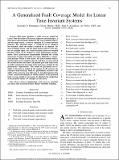| dc.contributor.author | Dominguez-Garcia, A. D. | |
| dc.contributor.author | Schindall, Joel E. | |
| dc.contributor.author | Kassakian, John G. | |
| dc.date.accessioned | 2010-03-08T16:54:54Z | |
| dc.date.available | 2010-03-08T16:54:54Z | |
| dc.date.issued | 2009-05 | |
| dc.date.submitted | 2008-11 | |
| dc.identifier.uri | http://hdl.handle.net/1721.1/52376 | |
| dc.description.abstract | This paper proposes a fault coverage model for linear time-invariant (LTI) systems subject to uncertain input. A state-space representation, defined by the state-transition matrix, and the input matrix, is used to represent LTI system dynamic behavior. The uncertain input is considered to be unknown but bounded, where the bound is defined by an ellipsoid. The state-transition matrix, and the input matrix must be such that, for any possible input, the system dynamics meets its intended function, which can be defined by some performance requirements. These performance requirements constrain the system trajectories to some region of the state-space defined by a symmetrical polytope. When a fault occurs, the state-transition matrix, and the input matrix might be altered; and then, it is guaranteed the system survives the fault if all possible post-fault trajectories are fully contained in the region of the state-space defined by the performance requirements. This notion of guaranteed survivability is the basis to model (in the context of LTI systems) the concept of fault coverage, which is a probabilistic measure of the ability of the system to keep delivering its intended function after a fault. Analytical techniques to obtain estimates of the proposed fault coverage model are presented. To illustrate the application of the proposed model, two examples are discussed. | en |
| dc.description.sponsorship | IEEE Reliability Society | en |
| dc.language.iso | en_US | |
| dc.publisher | Institute of Electrical and Electronics Engineers | en |
| dc.relation.isversionof | http://dx.doi.org/10.1109/tr.2009.2019496 | en |
| dc.rights | Article is made available in accordance with the publisher's policy and may be subject to US copyright law. Please refer to the publisher's site for terms of use. | en |
| dc.source | IEEE | en |
| dc.subject | linear time-invariant systems | en |
| dc.subject | invariant sets | en |
| dc.subject | fault coverage | en |
| dc.subject | Markov reliability modeling | en |
| dc.subject | Convex optimization | en |
| dc.title | A Generalized Fault Coverage Model for Linear Time-Invariant Systems | en |
| dc.type | Article | en |
| dc.identifier.citation | Dominguez-Garcia, A.D., J.G. Kassakian, and J.E. Schindall. “A Generalized Fault Coverage Model for Linear Time-Invariant Systems.” Reliability, IEEE Transactions on 58.3 (2009): 553-567. © 2009 IEEE | en |
| dc.contributor.department | Massachusetts Institute of Technology. Department of Electrical Engineering and Computer Science | en_US |
| dc.contributor.department | Massachusetts Institute of Technology. Laboratory for Electromagnetic and Electronic Systems | en_US |
| dc.contributor.approver | Kassakian, John G. | |
| dc.contributor.mitauthor | Schindall, Joel E. | |
| dc.contributor.mitauthor | Kassakian, John G. | |
| dc.relation.journal | IEEE Transactions on Reliability | en |
| dc.eprint.version | Final published version | en |
| dc.type.uri | http://purl.org/eprint/type/JournalArticle | en |
| eprint.status | http://purl.org/eprint/status/PeerReviewed | en |
| dspace.orderedauthors | Dominguez-Garcia, A.D.; Kassakian, J.G.; Schindall, J.E. | en |
| dc.identifier.orcid | https://orcid.org/0000-0002-5071-9182 | |
| dc.identifier.orcid | https://orcid.org/0000-0002-3443-5702 | |
| mit.license | PUBLISHER_POLICY | en |
| mit.metadata.status | Complete | |
